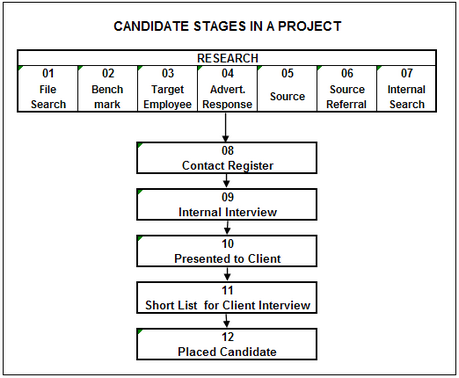A Project, also known as an Assignment, Search or Mandate, holds all the contractual data, billing information, documents, tasks and Candidate lists related to the Project.
A Project is primarily designed for managing the retained executive search process, in which a trust relationship exists between the Client and the firm undertaking the Project.
A typical Project involves a search to identify the best Candidates that can fill a high-end management or specialist position. A Project takes approximately 3 months from start to finish, involves multiple stages, multiple tasks, multiple team members and one or more Client contacts.
Fees for a Project are generally 33% of the total first year compensation of the successful Candidate, and are billed in 3 stages, with the first stage being a retainer fee. Subsequent fees are billed on milestones that are mutually acceptable to the search firm and the Client.
An important aspect of an executive search is the research process, which requires a wide net to be cast to identify potential Candidates from many sources. Advertising, Targeting and Sourcing are common research techniques to create long lists of potential Candidates. Then a screening process is used to derive a short list of the top Candidates for presentation to the Client.
Deskflow provides customizable workflow templates to control and manage the stages and task in each Project. Planned and Actual timelines can be tracked, and staged tasks assigned to team members. An example is shown below.
A Billing module prepares invoices and records incoming payments. An aged accounts receivable report is available for management. Alternatively, billing details may be exported to a back office accounting system.
Deskflow can be used to schedule Candidate screening interviews as well as coordinate Client-Candidate interviews. Scheduled events are tracked in the Deskflow Calendar and synchronized with each User's Outlook calendar.
A Deskflow Project has thirteen categories of information, with each category assigned a distinct tab. A Project progresses sequentially through the tabs or stages shown below:
Example: Project Main Page
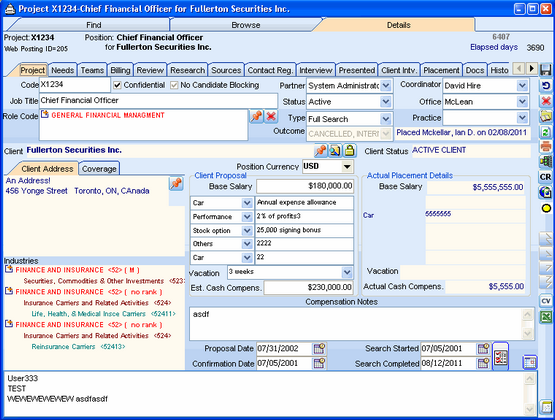
The Project View is organized into horizontal tabs, each tab showing a different stage in the Project.
Example: Project View showing the main tab and 12 extra tabs

The Candidate Research tab is divided into six sub-tabs, each showing a different type of list. These are work lists from which Candidates are selected for the Long List or Contact Register as it is known in Deskflow. The Candidate Research module in Deskflow manages the following lists:
•File Search Candidates list (for potential Candidates found in the Deskflow database)
•Benchmark Candidates list (for the ideal but unavailable Candidates)
•Target Companies list and Target Companies Employees list (for head-hunting targets)
•Advertising Respondents List (for Candidates responding to advertised positions)
•Sources list and Source Referrals list
•Internal Candidates list (for Candidates within the Client organization)
Example: Candidate Research tab and six sub-tabs
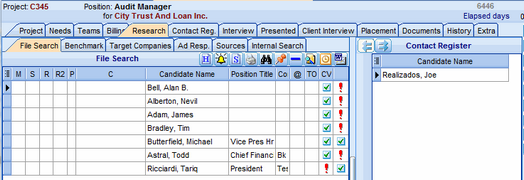
The Project Target Companies tab tracks target Companies and target Company employees.
Example: Target Companies and Target Company Employees
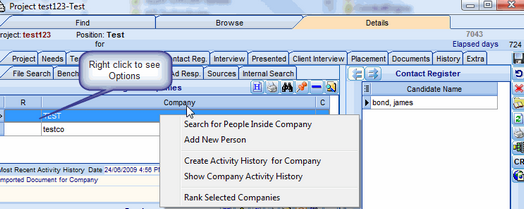
The Project Sourcing tab tracks Sources and Referrals (recommended Candidates) from the sources:
Example: Project Sources and Sourced Referrals
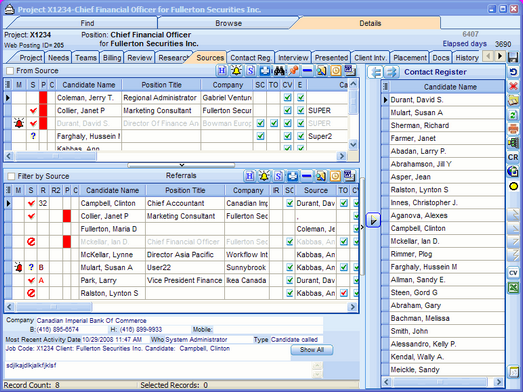
Candidate Stages
As Candidates progress through the Candidate funnel, the number of Candidates decreases at each successive stage of the process: selection, research, screening, interviewing, presentation, Client interviews and placement.
Candidates are assigned Stage Numbers from 1 to 12.
From a Candidate profile, the centre of the Person tab shows what Projects a Candidate has been considered for, and the highest Stage reached in the Candidate funnel for each Project. A reverse sort of the column called Highest will display a Candidate's highest stage per Project.
Example: Candidate Stages in a Project
